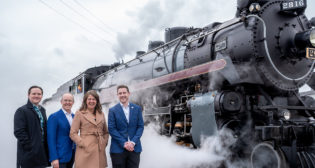
Railroads File Suit Over CARB’s New In-Use Locomotive Regulation (Updated with TD Cowen Commentary)
Written by Marybeth Luczak, Executive Editor
The Association of American Railroads (AAR) and the American Short Line and Regional Railroad Association (ASLRRA) on June 16 filed a lawsuit, on behalf of their members, against the California Air Resources Board (CARB), challenging its In-Use Locomotive Rule, passed April 27, which they said “would limit the useful life of today’s locomotive fleet (more than 25,000 locomotives) and mandate their premature replacement with zero-emissions locomotives.”
According to CARB, under the In-Use Locomotive Regulation—the first-of-its-kind in the nation, and is to take effect October 2023—locomotive operators will be required to pay into a spending account, and the amount will be determined by the emissions they create while running in California. Companies will be able to use the funds to upgrade to cleaner locomotive technologies, CARB said; locomotives will also have a 30-minute idling limit. Additionally, switch, industrial and passenger locomotives built in 2030 or after will be required to operate in zero-emissions configurations while in California, and in 2035 for freight line haul.
In the lawsuit filed in the Eastern District of California, AAR and ASLRRA “argue that CARB lacks the legal authority to promulgate the In-Use Locomotive Rule,” the associations reported June 16. “Due to the interconnected nature of rail operations and the need for uniform regulatory policies, Congress, the courts, federal regulators, and even CARB itself have long acknowledged that the federal government has exclusive authority to regulate rail operations.” As a part of the suit, the groups said they filed to “preliminarily enjoin implementation and enforcement of the rule while the district court considers the case.”
“While the urgency to act is real and unquestionable, CARB uses unreasonable, flawed assumptions to support a rule that will not result in emissions reductions,” AAR President and CEO Ian Jefferies said. “Railroads have urged CARB to take the proven path of collaboration and build on our shared successes, but those arguments were rejected out of hand. Railroads are working toward reliable, efficient zero-emissions technologies; however, they cannot simply be willed into immediate existence by policymakers.”
The railroads’ partnerships with CARB in past years “have successfully reduced emissions from line haul and yard operations across the state,” according to AAR and ASLRRA, which noted that initiatives such as zero-emission cranes, yard service vehicles and other technology are at work in yards across California and the nation as anti-idling systems, fuel management systems and the use of renewable fuels are simultaneously reducing locomotive emissions.
Although the industry continues to pilot technologies such as battery-electric- and hydrogen fuel cell-powered locomotives that can potentially reduce greenhouse gas emissions and criteria pollutants across the State of California and nationwide, the associations reported, zero-emissions locomotive technology “has not been sufficiently tested in prototype or operational service and is not commercially available on the market today.” Additionally, they said, “a clear technological path has not yet emerged.”
“While the spirit behind this regulation is consistent with railroad’s environmental commitment, the rule itself is unworkable and infeasible for short lines—its implementation would literally bankrupt some small business short lines,” ASLRRA President Chuck Baker said. “And the rulemaking does not acknowledge the impact of the elimination of some short line rail service to Californians. For shippers, it eliminates an efficient means to market and threatens the competitiveness of California’s products. For the public, it means the rising cost of products and a modal shift to trucks—a far less safe means of transportation resulting in more fatalities and injuries, more congestion on California’s roads, more burden on the California taxpayer to pay for road damage, and more micro plastics from shredded truck tires in the environment and water supply.”
Similar to the Class I railroads, short line railroads are testing hydrogen and battery-electric powered locomotives, installing fuel optimization software and anti-idling technology, testing biodiesel and renewable diesel, and exploring fuel additives to lower emissions, in addition to upgrading locomotives to higher tier levels when practical, according to AAR and ASLRRA. They added that short lines largely rely on government support for these targeted pilot projects.
TD Cowen Insight
TD Cowen equipment and rail analysts Jason Seidl, Matt Elkott and Elliot Alper recently hosted an expert panel to discuss the CARB locomotive rules. “Perhaps counterintuitively, in the unlikely event that the rules hold in current form, and also go national, the resulting record build cycle may not be the best-case scenario for OEMs, as demand would be too overwhelming for the current duopoly, possibly raising new-entrant risk,” they note. “The more plausible scenario, according to our panelists, is that a multiyear battle has just commenced, involving California, the railroads, the EPA, and stakeholders in rail and other sectors. This could entail deadline extensions, rule modifications, and more states jumping in. California still needs a waiver from the EPA for having a standard different from the national one. The net benefit in the next several years could be enjoyed by locomotive, engine and component manufacturers, primarily Wabtec, and to a lesser extent Caterpillar/Progress Rail, and possibly Cummins, though more on the passenger side.
“As to the OEM opportunity, the language of the new regulation leaves some things open to interpretation. A 2030 ban on locomotives older than 23 years, if adopted nationally, would set off the biggest build cycle in memory and represent a multi-billion-dollar revenue opportunity for the OEMs. Wabtec has roughly two-thirds of the existing market but appears to be getting a much higher percentage on incremental demand, including favorable growth prospects for modernizing non-Wabtec equipment. It’s unclear whether the 2030 ban on locomotives older than 23 years treats a modification date as a new build date, but it does not appear to do so based on a strict reading of the rule.
“Could other states follow? The panel noted that a potential Illinois adoption of similar rules would effectively make the regulation national, given the main interchange hub of Chicago. Some Northeast states could also join, but the effect of that would be less dramatic than in Illinois. Going national will also be a function of the political balance of power, as Democratic administrations would be much more likely to mean EPA support for the regulations.
“Could this trigger a build cycle anyway? Barring an outright nixing by the EPA, the new rule could accelerate the railroads’ investment in new locomotive technologies in anticipation of wider adoption. The new-vs.-rebuilt dynamic could be affected, but we look to gain more clarity on how CARB distinguishes between the two. Wabtec’s FLXDrive battery-electric linehaul locomotive and Caterpillar’s battery-electric switcher and linehaul locomotives and its hydrogen locomotive partnership with Chevron are likely to garner even more attention following the CARB announcement.
“We believe the best-case scenario for the locomotive OEMs and component suppliers, though not for the railroads, is for the regulation to go national while at the same time getting modified to reflect a greater deal of flexibility for the railroads on compliance deadlines and criteria. The current version poses serious challenges to the grid, the carriers and other industry stakeholders. It also elevates the risk of a new locomotive manufacturing entrant, a risk that is currently very low, in our view”
In a related development, AAR outlined how “smart” federal policies can further advance the rail industry’s efforts to combat climate change in new report released June 13.
Further Reading:
Zero/Low-Emission Locomotive Global Roundup
New Locomotive Build Market: Nonexistent for Now?



